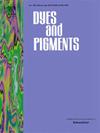Interface engineering by module customization of π-conjugated groups in hole transport materials for perovskite solar cells: Theoretical simulation and experimental characterization
IF 4.1
3区 工程技术
Q2 CHEMISTRY, APPLIED
引用次数: 0
Abstract
Interface engineering is an effective approach to improve the power conversion efficiency (PCE) of perovskite solar cells (PSCs). To achieve the regulation of intermolecular and interfacial interactions from the point of view for the molecular design of hole transport materials (HTMs), the HTMs of CY9 and CY10 are designed by conjugate management on side-chain groups of carbazole-diphenylamine derivatives. Theoretical simulation demonstrates that the larger π-conjugate units in side-chain of CY10 improve the molecular planarity, thereby enhancing the potential for intermolecular π-π stacking and charge coupling. Molecular dynamics (MD) and first-principles simulations indicates that CY10 is uniformly distributed and compactly arranged on perovskite surface, which enhances intermolecular coupling strength, promotes hole transfer, and facilitates the interfacial interactions at perovskites/HTMs interface. The experimental results validated the reliability of the theoretical simulations, which demonstrated that CY10 as HTM exhibited tighter intermolecular π-π stacking, smooth film morphology, low interfacial defect density, and effective suppression of energy loss caused by interfacial non-radiative recombination. Consequently, the PSC devices based on CY10 exhibited a higher VOC than CY9. This work presents a strategy from the point of view for the molecular design of HTMs to enhance the interfacial interactions of the perovskite/HTM interface.

通过模块定制π-共轭基团在过氧化物太阳能电池空穴传输材料中的界面工程:理论模拟和实验表征
界面工程是提高过氧化物太阳能电池(PSCs)功率转换效率(PCE)的有效方法。为了从空穴传输材料(HTMs)分子设计的角度实现对分子间和界面相互作用的调控,我们通过对咔唑-二苯胺衍生物侧链基团的共轭管理设计了 CY9 和 CY10 的 HTMs。理论模拟表明,CY10 侧链中较大的 π 共轭单元改善了分子的平面性,从而提高了分子间 π-π 堆积和电荷耦合的潜力。分子动力学(MD)和第一性原理模拟表明,CY10 在包晶表面均匀分布且排列紧凑,从而增强了分子间耦合强度,促进了空穴传输,并有利于包晶/HTMs 界面的界面相互作用。实验结果验证了理论模拟的可靠性,表明作为 HTM 的 CY10 表现出更紧密的分子间 π-π 堆叠、平滑的薄膜形貌、较低的界面缺陷密度,并有效抑制了由界面非辐射重组引起的能量损失。因此,与 CY9 相比,基于 CY10 的 PSC 器件具有更高的 VOC。这项研究从 HTM 分子设计的角度提出了一种增强包晶/HTM 界面相互作用的策略。
本文章由计算机程序翻译,如有差异,请以英文原文为准。
求助全文
约1分钟内获得全文
求助全文
来源期刊

Dyes and Pigments
工程技术-材料科学:纺织
CiteScore
8.20
自引率
13.30%
发文量
933
审稿时长
33 days
期刊介绍:
Dyes and Pigments covers the scientific and technical aspects of the chemistry and physics of dyes, pigments and their intermediates. Emphasis is placed on the properties of the colouring matters themselves rather than on their applications or the system in which they may be applied.
Thus the journal accepts research and review papers on the synthesis of dyes, pigments and intermediates, their physical or chemical properties, e.g. spectroscopic, surface, solution or solid state characteristics, the physical aspects of their preparation, e.g. precipitation, nucleation and growth, crystal formation, liquid crystalline characteristics, their photochemical, ecological or biological properties and the relationship between colour and chemical constitution. However, papers are considered which deal with the more fundamental aspects of colourant application and of the interactions of colourants with substrates or media.
The journal will interest a wide variety of workers in a range of disciplines whose work involves dyes, pigments and their intermediates, and provides a platform for investigators with common interests but diverse fields of activity such as cosmetics, reprographics, dye and pigment synthesis, medical research, polymers, etc.
 求助内容:
求助内容: 应助结果提醒方式:
应助结果提醒方式:


